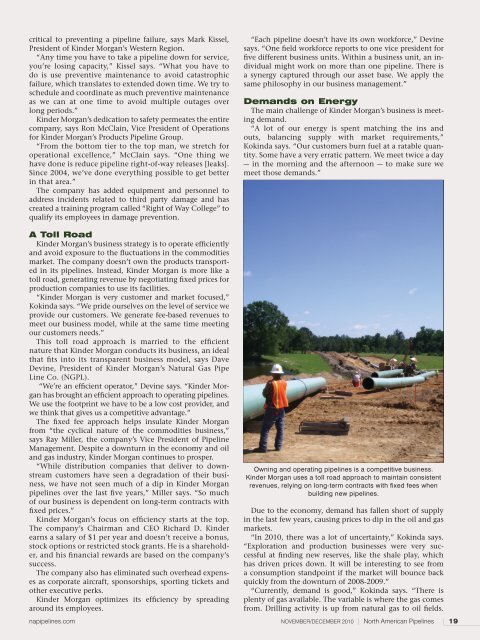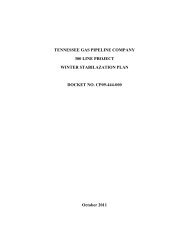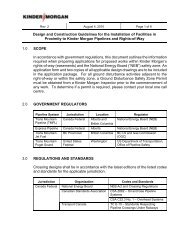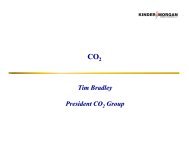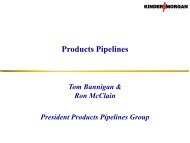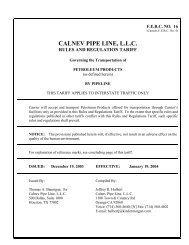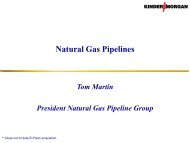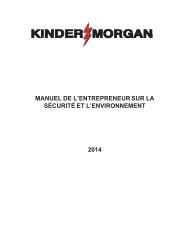PDF Article - Kinder Morgan
PDF Article - Kinder Morgan
PDF Article - Kinder Morgan
You also want an ePaper? Increase the reach of your titles
YUMPU automatically turns print PDFs into web optimized ePapers that Google loves.
critical to preventing a pipeline failure, says Mark Kissel,<br />
President of <strong>Kinder</strong> <strong>Morgan</strong>’s Western Region.<br />
“Any time you have to take a pipeline down for service,<br />
you’re losing capacity,” Kissel says. “What you have to<br />
do is use preventive maintenance to avoid catastrophic<br />
failure, which translates to extended down time. We try to<br />
schedule and coordinate as much preventive maintenance<br />
as we can at one time to avoid multiple outages over<br />
long periods.”<br />
<strong>Kinder</strong> <strong>Morgan</strong>’s dedication to safety permeates the entire<br />
company, says Ron McClain, Vice President of Operations<br />
for <strong>Kinder</strong> <strong>Morgan</strong>’s Products Pipeline Group.<br />
“From the bottom tier to the top man, we stretch for<br />
operational excellence,” McClain says. “One thing we<br />
have done is reduce pipeline right-of-way releases [leaks].<br />
Since 2004, we’ve done everything possible to get better<br />
in that area.”<br />
The company has added equipment and personnel to<br />
address incidents related to third party damage and has<br />
created a training program called “Right of Way College” to<br />
qualify its employees in damage prevention.<br />
“Each pipeline doesn’t have its own workforce,” Devine<br />
says. “One field workforce reports to one vice president for<br />
five different business units. Within a business unit, an individual<br />
might work on more than one pipeline. There is<br />
a synergy captured through our asset base. We apply the<br />
same philosophy in our business management.”<br />
Demands on Energy<br />
The main challenge of <strong>Kinder</strong> <strong>Morgan</strong>’s business is meeting<br />
demand.<br />
“A lot of our energy is spent matching the ins and<br />
outs, balancing supply with market requirements,”<br />
Kokinda says. “Our customers burn fuel at a ratable quantity.<br />
Some have a very erratic pattern. We meet twice a day<br />
— in the morning and the afternoon — to make sure we<br />
meet those demands.”<br />
A Toll Road<br />
<strong>Kinder</strong> <strong>Morgan</strong>’s business strategy is to operate efficiently<br />
and avoid exposure to the fluctuations in the commodities<br />
market. The company doesn’t own the products transported<br />
in its pipelines. Instead, <strong>Kinder</strong> <strong>Morgan</strong> is more like a<br />
toll road, generating revenue by negotiating fixed prices for<br />
production companies to use its facilities.<br />
“<strong>Kinder</strong> <strong>Morgan</strong> is very customer and market focused,”<br />
Kokinda says. “We pride ourselves on the level of service we<br />
provide our customers. We generate fee-based revenues to<br />
meet our business model, while at the same time meeting<br />
our customers needs.”<br />
This toll road approach is married to the efficient<br />
nature that <strong>Kinder</strong> <strong>Morgan</strong> conducts its business, an ideal<br />
that fits into its transparent business model, says Dave<br />
Devine, President of <strong>Kinder</strong> <strong>Morgan</strong>’s Natural Gas Pipe<br />
Line Co. (NGPL).<br />
“We’re an efficient operator,” Devine says. “<strong>Kinder</strong> <strong>Morgan</strong><br />
has brought an efficient approach to operating pipelines.<br />
We use the footprint we have to be a low cost provider, and<br />
we think that gives us a competitive advantage.”<br />
The fixed fee approach helps insulate <strong>Kinder</strong> <strong>Morgan</strong><br />
from “the cyclical nature of the commodities business,”<br />
says Ray Miller, the company’s Vice President of Pipeline<br />
Management. Despite a downturn in the economy and oil<br />
and gas industry, <strong>Kinder</strong> <strong>Morgan</strong> continues to prosper.<br />
“While distribution companies that deliver to downstream<br />
customers have seen a degradation of their business,<br />
we have not seen much of a dip in <strong>Kinder</strong> <strong>Morgan</strong><br />
pipelines over the last five years,” Miller says. “So much<br />
of our business is dependent on long-term contracts with<br />
fixed prices.”<br />
<strong>Kinder</strong> <strong>Morgan</strong>’s focus on efficiency starts at the top.<br />
The company’s Chairman and CEO Richard D. <strong>Kinder</strong><br />
earns a salary of $1 per year and doesn’t receive a bonus,<br />
stock options or restricted stock grants. He is a shareholder,<br />
and his financial rewards are based on the company’s<br />
success.<br />
The company also has eliminated such overhead expenses<br />
as corporate aircraft, sponsorships, sporting tickets and<br />
other executive perks.<br />
<strong>Kinder</strong> <strong>Morgan</strong> optimizes its efficiency by spreading<br />
around its employees.<br />
Owning and operating pipelines is a competitive business.<br />
<strong>Kinder</strong> <strong>Morgan</strong> uses a toll road approach to maintain consistent<br />
revenues, relying on long-term contracts with fixed fees when<br />
building new pipelines.<br />
Due to the economy, demand has fallen short of supply<br />
in the last few years, causing prices to dip in the oil and gas<br />
markets.<br />
“In 2010, there was a lot of uncertainty,” Kokinda says.<br />
“Exploration and production businesses were very successful<br />
at finding new reserves, like the shale play, which<br />
has driven prices down. It will be interesting to see from<br />
a consumption standpoint if the market will bounce back<br />
quickly from the downturn of 2008-2009.”<br />
“Currently, demand is good,” Kokinda says. “There is<br />
plenty of gas available. The variable is where the gas comes<br />
from. Drilling activity is up from natural gas to oil fields.<br />
napipelines.com NOVEMBER/DECEMBER 2010 | North American Pipelines 19


